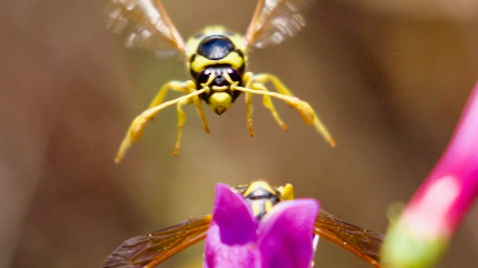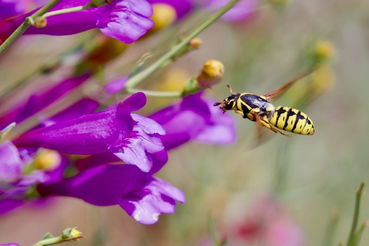Pollen Wasp
by Dan Sandri
A much friendlier wasp
June 20, 2025

by Dan Sandri
These days there is a wasp flying around Mount Diablo State Park’s Bunchleaf Penstemon (Penstemon heterophyllus) that looks somewhat like a Western Yellowjacket (Vespula pensylvanica), but is much more peace-loving and delightful! It is a Pollen Wasp: Pseudomasaris vespoides. It isn’t a pest or a predator - this Pollen Wasp behaves more like a bee. Pseudomasaris vespoides is a specialist that relies solely on Penstemon for pollen and nectar to feed its larvae. To find it, look for the Penstemon.
These wasps differ from yellowjackets in that they are larger and have clubbed antennae, among other differences. Unlike most bees, they do not carry nectar and pollen on their legs. They carry pollen and nectar back to their mud nests using their crops. Like most native bees, each female wasp is a solitary nester, not a communal nester – each nest cell contains one egg and the nectar and pollen to feed the larva when the egg hatches. A mud nest may be a collection of parallel cells attached to a rock.
Certain Penstemon plants, including some endangered plants across the Western United States, rely on Pseudomasaris vespoides for pollination – they would go extinct without the wasp. Pollen wasps have long tongues that enable them to reach the nectar at the base of long, tubular flowers. If you watch Pseudomasaris vespoides wasps collect nectar from Bunchleaf Penstemon, you will hear them too, as their backs make a rasping sound when they rub against spines in the Bunchleaf Penstemon flowers.
Note that there are at least three species on Pseudomasaris in Mount Diablo State Park, but if you see one on Bunchleaf Penstemon, it will be Pseudomasaris vespoides. The upper parts of Mount Diablo have a lot of Penstemon right now, and a lot of these wasps. Perhaps try Mary Bowerman Fire Interpretive Trail or one of the other higher elevation trails.



